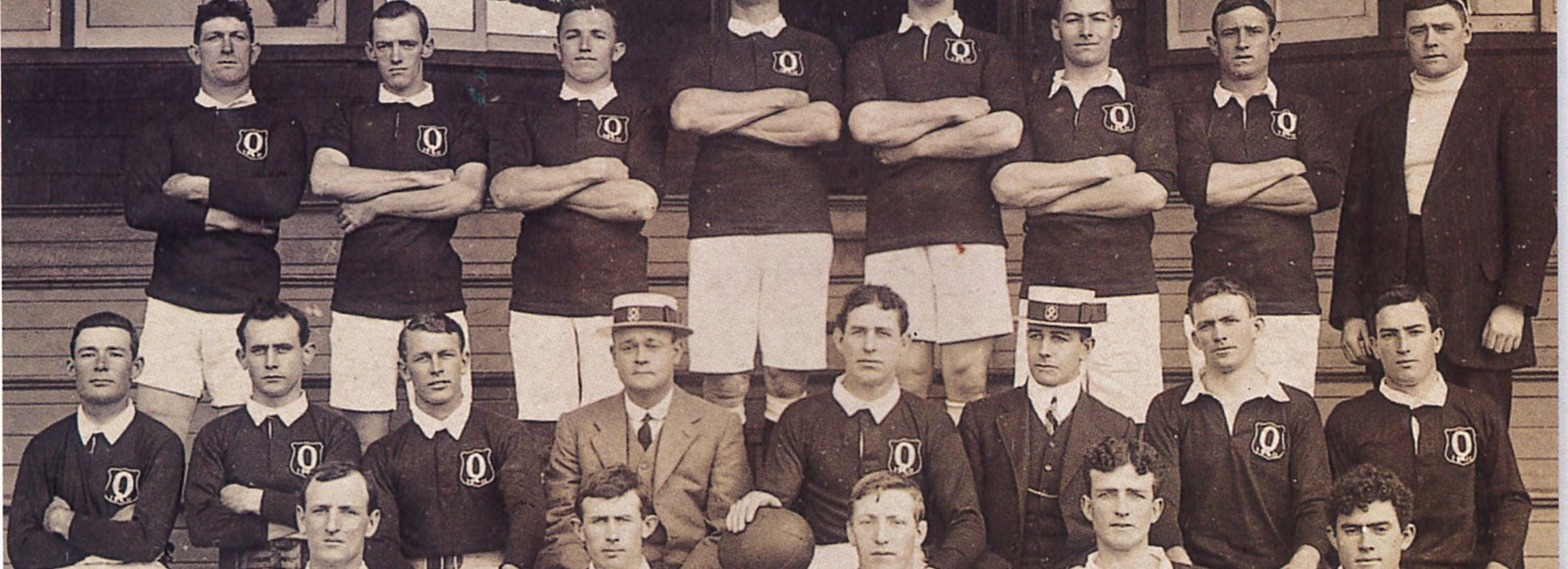
Headgear to Helmets is a documentary feature film that provides an insight into rugby league players who enlisted in the Australian and New Zealand Army Corps and saw active duty during the ill-fated Gallipoli Campaign.
Headgear to Helmets - Herbert Bolt
Headgear to Helmets - Stan Carpenter
Headgear to Helmets - Paddy Bugden
Headgear to Helmets: Tom Bruce
The following story is the first in a series of seven.
George Duffin was a hero on both sides of the Tweed River. Fullback for Western Suburbs Rugby Union first grade team in Sydney in 1906 and 1907, he was one of the pioneers in the new code, appearing for Western Suburbs in their first ever Rugby League match.
Duffin played seven matches for the Magpies in that historic season before shifting north for the first ever season of club football in Queensland. He was a star in the fledgling Brisbane competition for six seasons, being a near permanent fixture in their representative combinations over that time and making 18 appearances for Queensland between 1909 and 1913.
Duffin's qualities as a utility are evidenced by the fact that he appeared in every backline position except halfback, and the fact that he captained the state.
Duffin's sole Test came at Brisbane in 1909 against New Zealand, when Australia posted a 10-5 win. Selected in the unfamiliar position of winger, he was one of nine Queenslanders included in the Second Test of the series.
As the match was played in Brisbane, the need to include local talent to attract a crowd appeared overdone, but the Australian XIII surprised all their critics by leveling the series after the Kiwis had won the first encounter 19-11. Duffin sustained a badly cut nose as a souvenir of his appearance but helped construct the match winning try, when he backed up some clean-up work by Bill Heidke, which turned defence into attack, and sent Charlie Woodhead on a 50-metre run to the tryline.
In the summer months, Duffin was also a very fine first grade cricketer who could open both the batting and bowling to good effect.
Although not married, Duffin enlisted on March 1, 1915 and was assigned to C Coy 18th Battalion. His attestation papers reveal that he was then aged 27 years, 7 months, was a warehouseman by occupation, stood 5ft 7in and weighed just over ten stone (64.5 kg). At that time he was back living with his father in Sydney.
George Duffin's career as a soldier would be tragically brief. He sailed from Australia on HMAT A40 "Ceramic" on June 25, and after a few weeks training in Egypt was thrown into the fray, landing on the Peninsula on August 20. Unfortunately the new men from the 18th Battalion were used as cannon fodder, as Les Carlyon describes in his book "Gallipoli".
"The 18th had been ashore three days…These new men were big and rosy-cheeked; they had never been under fire and were full of hope. They arrived a few hundred yards west of Hill 60 at dawn on August 22. Their officers were called to a conference and told they were to attack with bombs and bayonets only. But they had no bombs, an officer interjected. Well, they'd just have to do their best without them. They charged the Turkish trenches 750 strong and came out with 383 casualties, half of them dead. Hill 60 was still unconquered and a new battalion had been ruined. Troops were short and compromises inevitable; there was still something contemptible about the way the 18th had been sent out to die."
George Duffin was one of those who perished in the attack, but his body was never found and there were misleading reports that he had been captured and was being held as a prisoner of war.
An inquiry nearly two years later found that he probably died at Gallipoli "on or about August 22" from a direct hit by a shell, which would usually mean there was no body to be found. It may have been quick and relatively pain-free for George, if not his family in the months that followed. After the finding it was even reported that he had died in France.
One cannot begin to imagine the emotional pain his kinfolk must have felt when he was posted as missing, the two years of emptiness before final confirmation that he had been killed. There would be many more families who would experience the same heartbreak before the war was finished.
Headgear to Helmets will premiere on Tuesday, July 14 at the National Rugby League's Heroes & Legends Museum.
Heroes & Legends Museum
Rugby League Central
Driver Avenue
Moore Park 2021
If you have any stories which highlight rugby league's connection to Gallipoli, please contact: museum@rugbyleaguecentral.com.au


